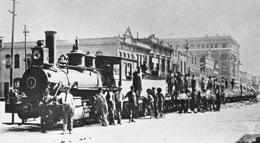On December 25, 1907, the Yakima Valley Transportation Company operates its first electric trolley over a three-mile line in North Yakima (now Yakima). Following an "inaugural special" on Christmas Eve, public runs begin at 2 p.m. on Christmas day at the company's offices at First and B streets. Since no passing track has yet been built, only one car is in operation, and it runs (jammed far beyond capacity) every 40 minutes. By the end of the day, 1,320 five-cent fares are collected.
To celebrate the inaugural run, company president A. J. "Jack" Splawn led company directors, the city council, and members of the press on a tour of the trolley facilities -- a small dynamo and repair pit -- both housed outdoors on a stretch of Yakima Avenue so muddy that the dignitaries had to wear high boots. The guests then climbed aboard Car 18 -- recently leased from Tacoma together with Number 36 -- for the 14-minute trip to the terminus at Nob Hill Boulevard. President Splawn took the wheel, distributed Havana cigars at the terminus, and then led the group back to its starting place. Bystanders cheered and tossed their hats as the trolley rolled by.
Plans for an interurban railway had been floated as early as 1900, but a franchise had not been agreed to until 1906, and difficulties in raising $500,000 in capital had further delayed construction. Under the terms of its franchise with the city, the company was required to build at least three miles of "operating railroad" by January 1, 1908. Ground was broken on September 9, 1907, less than four months before the opening, and by mid-December, more than 100 workers were building the line.
By September 1908, the system boasted five cars, all of which ran at capacity to take 35,000 visitors to the Washington State Fair. But in 1909, unable to the find local capital needed to expand the railroad as required by the franchise, the company was sold to Oregon Railway & Navigation, a subsidiary of the Union Pacific.
By 1920, 48 track miles had been laid (or 44 miles if you don't count double tracking where two tracks ran side by side), along lines to such locations as Selah, Henrybro, and Wiley City. Customers in these areas provided considerable freight business, including apple and lumber shipping, to the line. But despite sightseeing expeditions on the Seeing Yakima Car and service to popular destinations like the Washington State Fair and the Hippodrome amusement park, passenger ridership declined. By 1933, the Fair was no longer being held. Rail passenger service ended on February 1, 1947.
In 1974, trolley service for tourists was restarted with two trolleys imported from Portugal, which kept part of the line open when freight service ended in 1985. In 2002, the non-profit group Yakima Valley Trolleys took over operations after the previous operator experienced financial difficulties. The line has been named to the National Register of Historic Places and is owned by the City of Yakima.

